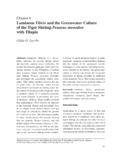Luminous Vibrio and the greenwater culture of the tiger shrimp Penaeus monodon with tilapia
- Global styles
- MLA
- Vancouver
- Elsevier - Harvard
- APA
- Help

閲覧/開く
日付
2017Page views
2,996ASFA keyword
AGROVOC keyword
Taxonomic term
Metadata
アイテムの詳細レコードを表示する
Share
抄録
Luminous vibriosis is a devastating infection of penaeid shrimp larvae and juveniles causing heavy mortalities. To counter the bacterial pathogen, Vibrio harveyi, shrimp farmers in the Philippines modified their growout culture method of the black tiger shrimp, Penaeus monodon, juveniles and developed the greenwater culture technique. This culture method involves the use of pond water of all-male, saline-tolerant Oreochromis hornorum as rearing water for the culture of shrimp juveniles in ponds. Such a modified culture of P. monodon juveniles was found effective in preventing the onset of luminous vibriosis. Basic studies revealed that antiluminous Vibrio factors are inherent in the bacterial, fungal, and microalgal flora of the tilapia water, dermal mucus, and gut that singly or collectively inhibit the growth of V. harveyi, in vitro. The skin mucus studies of other brackishwater fish species showed that the siganids, Siganus guttatus, and red hybrid tilapia (Oreochromis niloticus × Oreochromis mossambicus), as well as sea bass, Lates calcarifer, are promising alternative fish species for this novel shrimp culture method. A review of pond-simulated studies in tanks and ponds, similarly, confirmed these findings and the impact of the greenwater culture technique on water quality, including its economic benefits to the farmer. The greenwater culture of shrimp can sustain the successful production of shrimp juveniles by inhibition of the luminous Vibrio. This culture method is also currently used in the growout culture of the white shrimp, Litopenaeus vannamei.
Suggested Citation
Lio-Po, G. D. (2017). Luminous Vibrio and the greenwater culture of the tiger shrimp Penaeus monodon with tilapia. In P. W. Perschbacher & R. R. Stickney (Eds.), Tilapia in Intensive Co-culture (pp. 81–93). Chichester, UK: John Wiley & Sons, Ltd.
Type
Book chapterISBN
9781118970652Collections
- Books and Book Chapters [123]
Related items
Showing items related by title, author, creator and subject.
-
Studies on the efficacy of Sarafin® (sarafloxacin hydrochloride) on vibrios associated with vibriosis in black tiger shrimp (Penaeus monodon)
Pakingking, Rolando V., Jr. ; Lacierda, Erlinda; Torres, James L. (Fish Health Section, Asian Fisheries Society, 2002)
In vitro activity of Sarafin® (sarafloxacin hydrochloride) was determined against 7 luminous Vibrio harveyi isolates and 3 non-luminous Vibrio species (V. parahaemolyticus, V. alginolyticus and Vibrio species) isolated ...
; Lacierda, Erlinda; Torres, James L. (Fish Health Section, Asian Fisheries Society, 2002)
In vitro activity of Sarafin® (sarafloxacin hydrochloride) was determined against 7 luminous Vibrio harveyi isolates and 3 non-luminous Vibrio species (V. parahaemolyticus, V. alginolyticus and Vibrio species) isolated ... -
Bacterial loads in hatcheries and virulence of Vibrio spp. to larvae of the tiger shrimp Penaeus monodon
Torres, James L. (Bureau of Agricultural Research, Department of Agriculture, 2007)Shrimp hatcheries are high-density systems and are prone to diseases. A small-scale and a large-scale hatchery for the tiger shrimp Penaeus monodon in Iloilo, Philippines were monitored over two months for water quality ... -
Isolation of Vibrio spp. from Penaeus monodon (Fabricius) with red disease syndrome
From January 1990 to June 1993, 59% of the total juvenile to adult shrimp Penaeus monodon submitted for diagnosis at the Fish Health Section of the Aquaculture Department, Southeast Asian Fisheries Development Center, ...





